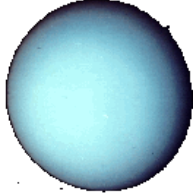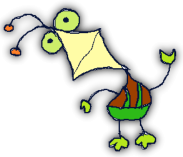The seventh planet can be seen fairly easily even with a small telescope. If you know where to look, Uranus appears as a
pale blue dot, unlike the pointlike stars which surround it.. Uranus was discovered quite by accident by William Herschel in 1781.
At first he thought the small blue object was a comet. But, after following it for a number of days, it became apparent that this
was a previously unknown member of the family of planets.
There has been only one spacecraft that has visted both Uranus and Neptune. That was Voyager II. All of the details we now know
of this planet were determined by this single probe. As often happens, the facts are nowhere near as enteraining as those found in our bad
science fiction movies.
Uranus is sometimes referred to as a sub-jovian planet. It presents a number of differences from either Jupiter or Saturn. The belts and zones
of those other two planets are missing, replaced by a uniform blue cast to the clouds, caused by the presence of methane gas in the upper
atmosphere. Uranus, along with Neptune, is distinctly different from the larger gas planets, Jupiter and Saturn. The two sub-jovian planets have a
very subtle blue-green color to them, due to the presence of methane in their atmospheres. Both of the outer planets have higher densities and a
greater proportion of H
2
0 in their composition. Their interiors are thought to be layered with molecular hydrogen, water, and molten rock.
Uranus’ strange magnetic field is generated by comprseed water in its interior. Around this big blue planet, we find a wonderful system of rings
and dozens of moons.





















































